40 Brilliant Large Group Games for 20+ people!

If you are running a small meeting or group workshop you probably have your favorite group activities that are easy to run and have proven to be effective in the past. But what about when your group size balloons to 20-40+ people? That's when well-designed large group games come into their own!
These activities create space for fun and play in big teams, whatever your environment. In this post, we'll share our favorite large group games alongside tips for running them too!
Whenever you design a session, you’ll want to consider the number of participants so you can plan activities appropriately. With very large groups, it gets harder to involve everyone, but it’s important that you do. Research has proven that play is vital not only at home or in the classroom, but at work too!
These large group games are designed to help you encourage play, connect and team build with groups of twenty or more people. They are also easy to run in parallel in smaller groups and are designed so that everyone can easily organize themselves easily.
We’ve categorized them for the following purposes, so you can find a suitable activity whether you are running a specific event or are looking for ideas for large group games you might use in the future!
Group games for breaking the ice
Do you need some large group games to get people moving and raise the energy level in the room? Or an activity that helps to break the ice and get participants comfortable talking to each other?
Consider these exercises and group activities for kicking off your next training workshop or large group team building session. They’re great to get large groups comfortable with one another in a fun, playful way.
| Large group game | Length in minutes | Participants | Difficulty |
|---|---|---|---|
| Rock-Paper-Scissors Tournament | 5 – 10 | 5 – 20 + | Low |
| Doodling Together | 10 – 30 | 4 – 200 | Low |
| Bang | 5 – 30 | 10 – 40 | Low |
| 3 Question Mingle | 30 – 60 | 20 – 40 | Low |
| Group Order | 5 – 10 | 5 + | Low |
| Icebreaker: The Group Map | 10 – 20 | 15 + | Low |
| Apple, Orange and Banana! | 5 – 15 | 12 – 30 | Low |
| One Word Method | 2 + | 4 – 20 | Low |
Rock-Paper-Scissors Tournament
This is fun and loud energizer game based on the well-known “Rock, Paper, Scissor” game. People play against each other in pairs until the first win. But instead of the losing players becoming eliminated from the tournament, they become a fan of the winner, and they cheer for them as the winner plays against a new opponent. You repeat the process until there are only two players left with a huge fan base cheering for them. The last two players have to play until one has won twice.
As this group activity tends to get loud, it’s best to play it somewhere outside. The great thing about this game is that it works whether you’re looking for a small group activity or large group game – it scales very easily and requires very little preparation!
Doodling Together
Doodling Together is a fun and creative game where the group gets to collaboratively draw postcards through a series of instructions as participants complete the postcards started by others. You can simply use this technique in parallel groups as the instructions are easy to follow.
It is a great group activity to establish creative confidence, collaborate effortlessly and build capacity for working together as a workshop group. Large group games rarely have the potential to be more hilarious and creative!
Bang!
Bang is a group game, played in a circle, where participants must react quickly or face elimination. One person stands in the middle of the circle as “the sheriff”, pointing at other players who must quickly crouch while those on either side of them quickly “draw”.
This is a good activity to generate laughter and it can also help with name-learning for groups getting to know each other. For a party or event with more than 30 people, it is best to play it in parallel groups. If you’re looking for energizers for large groups, this is one of the best group games to help get people excited and raise their energy level.
3 Question Mingle
In this group game, every participant creates three thoughtful questions that they want to ask other group members to get to know them better. People start to mingle to ask and answer questions in pairs. After asking a question and listening to the answer, they hand over that question. Thus, in each one-on-one meeting, participants will swap one question each.
This allows your team to learn interesting facts about each other and works with a group size of up to 50-60 people. A more thoughtful group game, 3 Question Mingle is great whether you’re working with internal teams or at a conference where you’re trying to encourage participation.
Group Order
Help teams get to know each other better with this fast, simple ordering game. Start with everyone standing and milling around your space and ask them to organize themselves into a line based on a criteria such as height, number of pets, time at your company or something else entirely! Helping friends learn something new about each other while getting into a line is a great addition to a team building session, and can help kick-off any group event.
Though the number of people playing is dependant on available space, I’ve found this quick game a hit, especially playing with ideas and ordering criteria that are a little outside of the box!
Icebreaker: The Group Map
Large group icebreakers are a wonderful opportunity to get to know each other and share a little about yourself with the team. This game invites participants to imagine the available space as a map of the world and place themselves where they are from.
This first step is often energetic as people try to find their relative geographies and move around the space. Next, ask your team to reflect on where they are from and then share some positive memories or experiences from that place. As with any large group activity, it’s helpful to go first and demonstrate the kind of thing people should share and set things off in a fun, light mood.
Apple, Orange and Banana!
Complexity isn’t your friend with a large group. Sometimes, all you need is a quick game with simple instructions in order to get things kicked off!
Apple, Orange and Banana! is a fast, active energizer that is great for teams of any size. Start by asking the group to form a circle and put their hands on the shoulders of the person in front of them. Next, ask everyone playing to jump forward when you say apple, jump back when you say orange and then jump and turn 180 degrees to put their hands on the shoulders of the person who has behind them. Work up to combining multiple commands to keep your team on their toes and generate lots of laughter too!
One Word Method
Some of the best games for playing with big groups of people are the simplest. This word game invites everyone in the room to contribute a single word to a collective sentence that grows as you go round the group.
I love running this game with kids and adults alike, and it’s really fun to see how things change as every player contributes a word. It also scales well with any number of players and it’s easy for people to learn and improve at with repeated turns. If you’re looking for a hilarious way to spend time with others without a need for equipment, this is a guaranteed hit where everyone wins!
Team building games for large groups
Facilitation techniques that help build team spirit, encourage teamwork and are suitable for running with lots of people are important to have in your toolkit.
These large group games put an emphasis on fostering trust and openness for better collaboration and managing team dynamics effectively. You could use them to initiate meaningful conversation or engage your party in engaging tasks where they work together in order to win.
Working together towards a common goal is often essential to increase cohesion within teams and you should definitely include such activities in a team building or development workshop. They’re also great for bringing a sense of play and fun to proceedings and encouraging everyone in your team to get involved.
| Large group game | Length in minutes | Participants | Difficulty |
|---|---|---|---|
| Draw your Coat of Arms | 40 – 60 | 6 + | Low |
| Marshmallow Challenge | 45 – 60 | 6 – 100 | Medium |
| Helium Stick | 5 + | 5 + | Low |
| History Map | 60 – 120 | 2 – 40 | Medium |
| Cross the Circle | 5 – 10 | 10 – 25 | Low |
| Egg Drop | 10 – 20 | 5 + | Low |
Draw your Coat of Arms
This group game helps group members to get to know each other better through a creative drawing exercise: Each participant draws their own coat of arms – a design that is unique to themselves, representing important characteristics, achievements and values of its owner.
If you want to direct the focus of this game then you can instruct your team to the best question to answer in each segment of the Coat of Arms. (E.g. What is something you are very good at? What is something your colleagues don’t know about you?).
When people are finished drawing, they present their work to in their group. The presentation part is practical to do in smaller groups. And whether you have a small or large group, you can arrange a neat Coat of Arms gallery by sticking all the drawings on the wall of the workshop room. Large group games where participants have something to show at the end can be especially effective and can really set the stage for a productive, interactive workshop.
Marshmallow Challenge
In eighteen minutes, teams of 3-5 people must build the tallest free-standing structure out of 20 sticks of spaghetti, one yard of tape, one yard of string, and one marshmallow. The marshmallow needs to be on top.
Since the instructions are fairly simple, it is easy to scale this activity up to 20-30 groups playing in parallel and competing who builds the highest structure. It emphasizes collaboration, group communication, leadership dynamics and problem-solving strategy – everything you want in your large group games. Also, there are marshmallows. All group activities are better with marshmallows!
Helium Stick
The Helium stick group activity gives a simple challenge to teams that require teamwork and coordination to manage. People are lined up in two rows facing each other, 5 to 10 people per row, depending on the length of the sticks you have for the game. Participants point with their index finger and hold their arms out in a way that a stick can be horizontally laid on their index fingers.
The task is to lower the stick to the ground while everyone’s index fingers stay in contact with the rod. Why Helium Stick? Often, the stick will rise first, like helium!
You can easily scale this activity for larger teams, just have as many sticks as the number of lines you will create, and the sub-groups will compete against each other who manages to lower their stick first. A gentle sense of competition can be great for bringing people together – try mixing teams if you’re working with multiple departments and encourage people who don’t normally interact to work together in this group activity.
History Map
Creating something collaboratively is a wonderful way of building team spirit with a large group or party. When we find time to reflect on our shared history and create something tangible as a result, even better!
Begin by rolling out a large piece of paper and draw a timeline representing a shared project, experience or the history of your group. Next, instruct everyone to use the materials provided (colored pens, pencils, even collage materials!) to add memorable experiences and moments to the timeline. History Map is a great activity to run with any number of people, though be sure you bring enough materials for everyone to get involved!
This activity works great on an online whiteboard, and be sure to encourage your virtual team to use GIFs and videos to illustrate the map further! Debrief by going round your team and inviting commentary and reflection.
Cross the Circle
While group discussions can be an effective way of helping bring everyone together, this can be time-consuming and unwieldy, especially with large groups. This activity is a fast, playful way to uncover commonalities and bring everyone together.
Begin with all the players around a circle except for one, who stands in the middle. The person in the middle then makes a statement such as “Cross the circle if you can speak a second language,” or “Cross the circle if you’ve worked here more than three years.” Instruct those who match the statement to cross the circle, though the last person to cross must then stand in the middle and make a new statement.
Continue this game as time allows, and try to give everyone a spot in the middle of the circle! It’s always interesting to note what everyone asks, and this approach allows the team to learn something new about each other too,
Egg drop
This classic group activity is a proven method of bringing a team together for a shared goal while also generating some laughs. Split your participants into two or more teams and provide each team with an egg, a heap of straws, tapes and any other crafting material you wish. Next, ask each group to create a structure that will allow the egg to fall over 7 feet without breaking. To add complexity, add some additional rules for building the structure, a time limit or some other constraint.
When designing a session for groups of more than 20 people, it pays to be organized.
In SessionLab, it’s easy to create a structured agenda for any group event or workshop. Add an opening section, core group activities and closing exercises to build your session in minutes.
Add clear timings and instructions for every activity to stay on track. Need to make changes on the day? Your event timing will automatically adjust so you’ll stay organized, whatever changes!
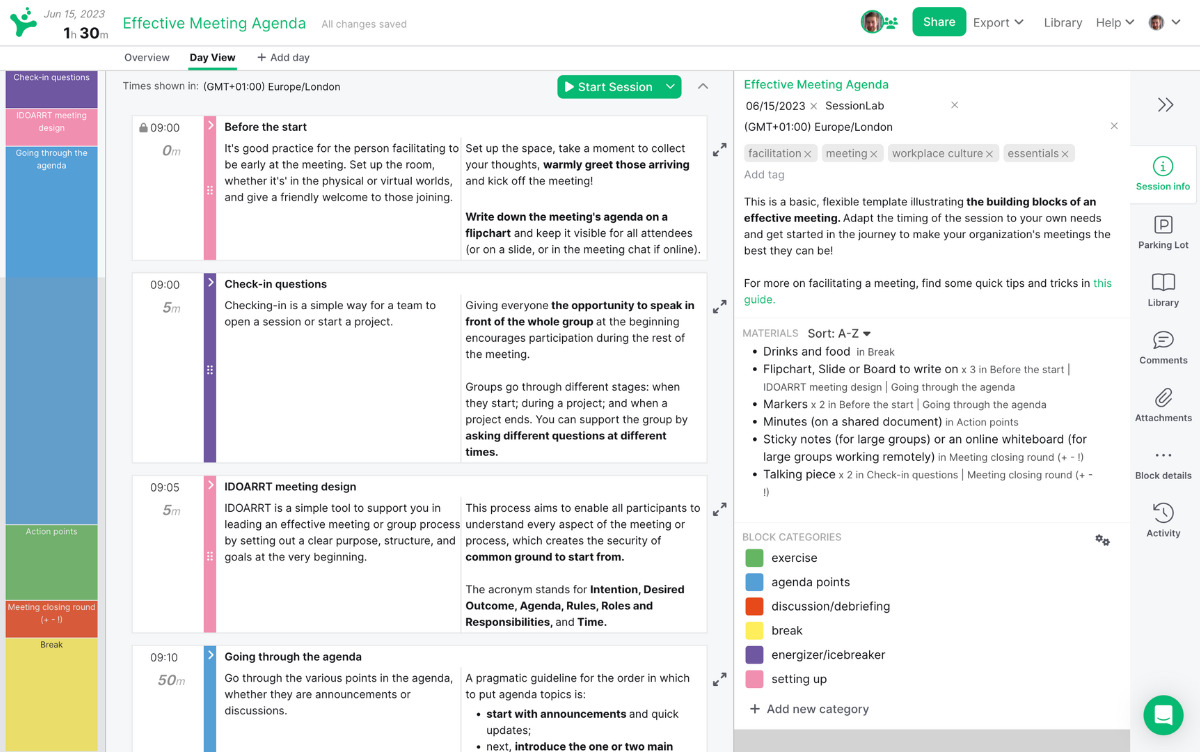
Party games for large groups
Classic party games are a great way to bring people together, even outside of a party environment. A sense of familiarity can help rouse any hesitant participants and they’re a proven method of helping people having fun.
While all of the games in this post could be used in a party setting, these large group party games are especially conducive to a party atmosphere. Whether at work, home or some other gathering, bring these party games to help engage any large group.
| Large group game | Length in minutes | Participants | Difficulty |
|---|---|---|---|
| Wink Murder | 5 – 15 | 6 + | Low |
| Snowball | 20 – 40 | 8 – 50 | Low |
| Human Knot | 15 – 30 | 7 – 40 | Low |
| What are you doing? | 5 – 30 | 10 – 40 | Low |
| Charades | 30 – 120 | 4 – 20 | Low |
Wink Murder
Inspired by the classic party games Werewolf and Mafia, Wink Murder is a fun game that asks an assassin try to “murder” other players by winking at them.
First, get the group in a circle. Next, get a folded piece of paper for each player and put a cross on one of them. Distribute the papers and let the group know that whoever gets the cross is the assassin. While they attempt to wink and murder the other team, the other players must guess who is the assassin and accuse accordingly. If they guess right, they win. If they guess wrong, they are out of the game.
Snowball
When you bring a large group together, there is almost always a period where everyone is feeling out the room and getting to know each other. Combining this stage with a fun, light activity is a wonderful way of breaking the ice and energizing the team too!
In Snowball, start by asking players to write the answer to five questions relating to a topic of your choosing on a piece of paper. Then, instruct players to join you in a circle in the middle of the room and crumple up their papers into a ball and get ready: you are about to have a snowball fight!
After play has gotten a bit rowdy, stop the game and invite each person to pick up the snowball closest to them. (Pick up another one if someone finds their own!) Finally, ask people to find who wrote the answers on the snowball they’re holding, have a quick chat, and then introduce them to the group!
Human Knot
Solving a puzzle as a team is a great way to bring a large number of people together. In this large group party game, start by organizing people into groups of 7-16 people and ask them to stand in a circle where they are close enough to reach and touch other players. Next, ask each person to close their eyes and connect hands with two other people. Have everyone open their eyes and try to untangle the human knot without breaking the chain.
This activity asks people to engage their problem solving skills while also getting to know each other better! It’s a fun game that scales well to very large groups with multiple human knots being played simultaneously.
What are you doing?
Improv games are a great way to introduce a sense of fun and creativity to any gathering. This group activity asks that a volunteer enters the centre of the room and starts miming an action.
When someone is ready to guess what the action is, they enter the circle and guess the action. The first player then comes up with another action the next player must perform and whispers it to them. They then mime that action for the rest of the group to guess. Encourage participants to be creative in the actions they mime and give to other players and hilarity will often ensue!
Charades
Charades is a classic game for both large and small groups for good reason. It’s fun, easy to teach and often brings a party together around shared jokes and memorable moments.
In a live setting, hand out paper and pens and ask each person to write words that they think would be fun or challenging to act out. Players then draw a a word at random and act it out for the rest of the group to guess.
Below, we’ve also included a version you can use to guess and have fun with teams online. You can replicate the act of writing down prompts using your online whiteboard and have people guess on webcam for a fun alternative that works great in gallery mode, even with groups of more than 20 people.
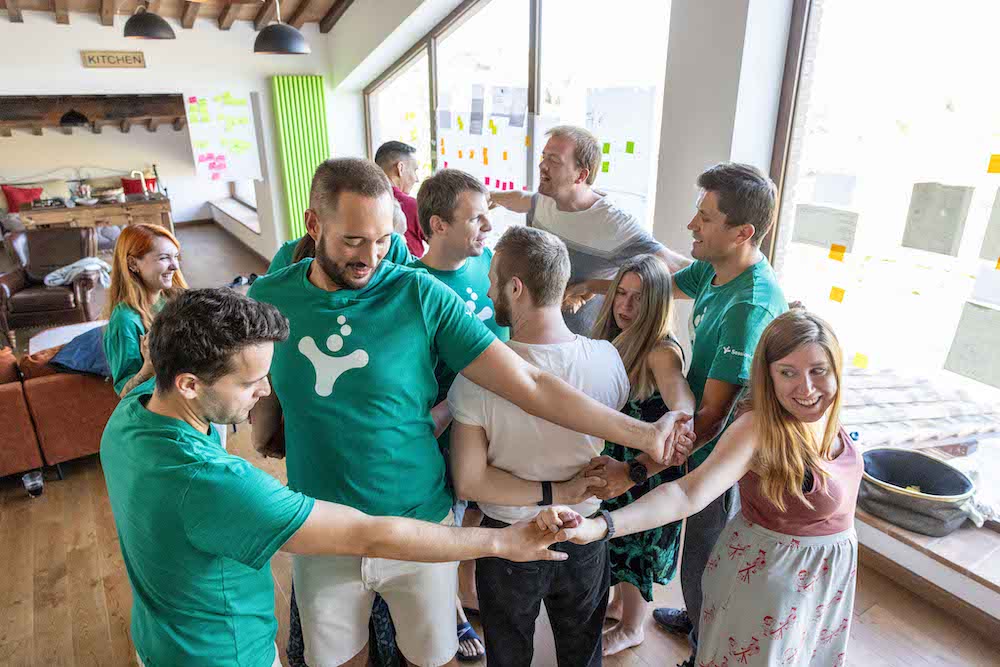
Active games for large groups
Most teams can benefit from getting away from their desks, standing up and having fun as a group. These activities involve lots of physical activity, running, and movement and can be run in a variety of spaces. There’s some crossover with the outdoor games you’ll see below, but these games can also work great in smaller spaces too!
Whether it’s for a party, team-building session, school event, or conference, try adding one of these ideas to your agenda when you need a burst of energy and physical activity in your schedule.
| Large group game | Length in minutes | Participants | Difficulty |
|---|---|---|---|
| Giants, Wizards, Elves | 15 – 30 | 10 + | Low |
| Spy | 3 – 5 | 8 – 15 | Low |
| Human Machine | 5 – 30 | 10 – 40 | Low |
| The Viking | 5 – 30 | 10 – 40 | Low |
| Dance Dance Dance | 5 – 30 | 10 – 40 | Low |
| Red Ball | 5 – 20 | 4 + | Low |
Giants, Wizards, Elves
This fantasy inspired game where points are awarded to Giants, Elves and Wizards is a fun one to bring to any party or event. To start, split your group into two teams. Each group forms a circle and decides what character they are going to all play for that round. Next, each group stands in a line facing each other and on the count of three, act out the role they have chosen.
Giants put their hands above their heads and roar. Elves put their hands over their ears to make them appear more elvish and make an elvish noise, while Wizards put their hands out as if casting and spell and making a buzzing noise.
When you face off, remember that Giants beat Elves, Elves beat Wizards and Wizards beat Giants. The winning team then has the chance to tag the other team before they get to the safe zone. Everyone who is tagged joins the winning team and you can repeat the game until only one team remains!
Spy
Start by getting all the players to stand in a circle. Tell them they are all spies, and that the aim of the game is not to be caught by the spy catcher. Ask them to silently guess who they believe is the spy catcher and to select one other person who will be their bodyguard. Do this without telling anyone! Next, ask participants to run around and try and position themselves so that their chosen bodyguard is between them and the spy catcher.
This is a great game to get people and energized, and it’s fun to debrief too! Especially if friends may have accused others of being a spy in order to win! Players might try and guess who they thought the spy catcher was or talk about how even a few simple rules can create utter chaos.
Human Machine
Improvisation and silliness combined with physical activity is a sure-fire way of getting a large group engaged in the fun! Start this game by explaining that each team will collaboratively create a machine using their bodies. Choose one person to start by improvising the sounds and movements of a part of a machine or robot. Everyone else observes and then one by one, they join the machine and improvise another part.
This can also be a fun game to play with two teams in tandem, or by briefing the players to create a collaborative machine with a particular purpose, such as generating power or cooking a complex meal. This game is best when played with large teams where the machines can become big and very energetic. Just make sure you have enough room!
The Viking
When looking to engage your team in physical activity, why not take a leaf from the pillaging toolkit of our favorite Nordic invaders? We’ll stop short of any actual raiding, but this game encourages participants to shout Norse words and physical actions to build energy as a team.
Start with everyone standing in a circle. One person begins by shouting the word “Mjolner!” and air punches to the left or right to transfer the role of Viking. Play proceeds loudly and actively, as players respond with different words and by throwing the role of Viking around the room. This is a playful game that works to bring a lot of noise and energy to big teams!
Dance, Dance, Dance.
No prizes for guessing the subject of this active game! Start by organizing everyone into groups of three to five people. Instruct the group that when you start playing a song, one player in each group becomes the leader and starts dancing. Everyone else must follow their moves. When the music changes, another player must then start dancing and lead the group.
This is a fun game to play with friends and for warming up new teams alike. For bonus points, invite participants to contribute a song to a shared playlist before your session so they recognize their favorite song as you go or can guess who contributed what track! I also like to award points after every round for the most exuberant or creative dance moves though when the goal is to have fun, every player wins!
Red Ball
In this improv game for large groups, participants are asked to pass imaginary objects around the circle, beginning with a red ball and ending up with objects like the keys to a Ferrari, a wriggling cat, a sleepy baby and more.
What begins as a quiet group game can quickly become a hotbed of creative chaos that encourages the group to act out the passing of various objects with energy. You might even give the group the opportunity to choose what to pass around next and give players points based on how they correctly (or incorrectly!) handle what’s given to them.
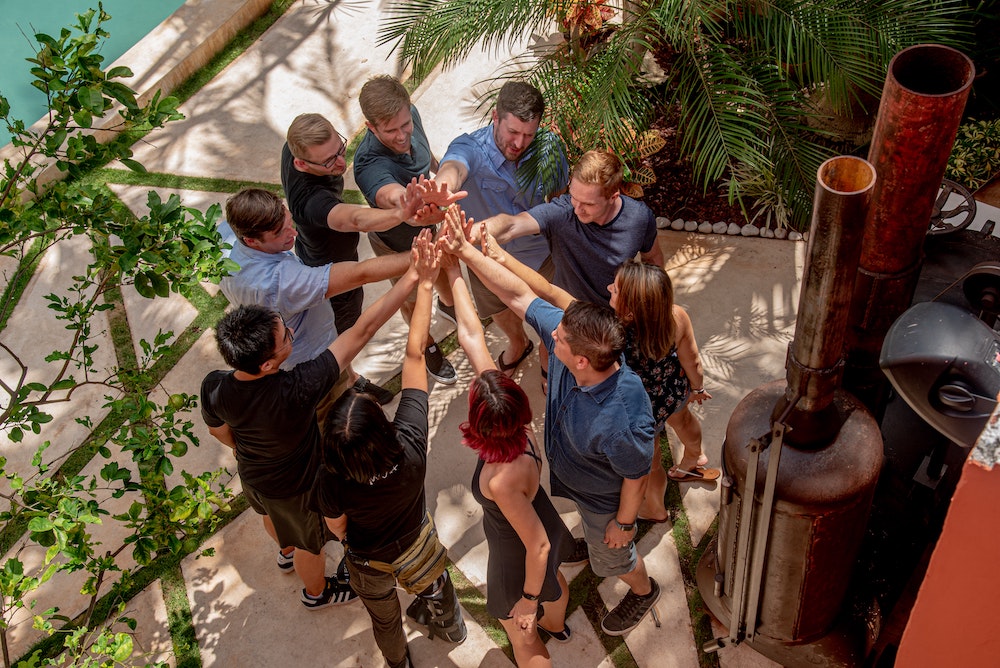
Fun outdoor games for large groups
When the weather allows, it’s great to take your team outside to play group games in the fresh air. These activities benefit from the outdoor setting as they require space to be run effectively.
Some of these games include asking your group to spread out, and a few of them have a bonus angle of including natural elements that can take advantage of your setting too. These are great games to play with young people and adults alike and always help raise the level of group energy!
| Large group game | Length in minutes | Participants | Difficulty |
|---|---|---|---|
| Blind Square – Rope Game | 30 – 45 | 4 – 20 | Low |
| Spider Web | 15 – 30 | 6 – 20 | Low |
| Crocodile River | 60 – 120 | 10 – 40 | Medium |
| Equilateral Triangles Collaboration | 30 – 45 | 6 – 20 | Low |
| Flamingo & Penguins | 5 – 10 | 5 + | Low |
| Stress Balls | 10 – 15 | 10 + | Low |
| Near and Far | 10 – 20 | 10 – 50 | Low |
Blind Square – Rope Game
Seemingly simple games are a wonderful way to engage large teams. We love that this activity encourages everyone to work together towards a common challenge while helping bring individual skills to the surface.
In this outdoor-friendly activity, begin by explaining that all a team has to do is make a length of rope into a perfect square. They have fifteen minutes to plan what they are going to do before everyone is blindfolded and play can commence. It’s so fun to see plans form and fall apart, and this activity works with kids and adults perfectly. Just remember to bring enough blindfolds for everyone! With especially large groups, separate into two teams and see who can create the most perfect square!
Spider Web
Games you can play outdoors with your team are great ways to enjoy the weather, spread out, and also be closer to nature while teambuilding.
This activity requires two ropes, some strong poles or trees, and a supervisor for each team playing. Safety and fun go hand-in-hand when it comes to large groups! Start by tying your ropes from one tree to the other to form a rectangle. Connect string between the top and bottom to form holes in a variety of shapes and sizes. Next, instruct your team that the aim of the game is to get all the members of the group through the web without touching the string or knocking the web.
This is a great game for encouraging players to work together and problem solve in the moment while also having a lot of fun!
Crocodile River
Getting outside is a wonderful way to break up a team-building session and put people into a new frame of mind. This can create a great foundation for setting hypothetical challenges such as trying to cross a treacherous river as a group.
This game asks two teams to work together to collect planks and get everyone in their group across the river. The challenge is that the planks are magic, and sink when not in contact with a person. We love that this game encourages collaboration and critical thinking, while also being fun enough for a party of adults or kids to engage and have fun as a group.
Equilateral Triangles Collaboration
This large group game is a great way to introduce the topic of collaboration in an approachable and fun way. Get all your players standing and start by explaining that everyone in a group should choose two people with whom they will form an equilateral triangle but they do not say who those people are. Next, everyone’s goal is to move around and form that triangle with the other players without verbally communicating.
This game can end up with some hilarious outcomes as your group maneuvers around while aiming to get in sync with one another! It also has some very teachable lessons about clear communication and team alignment you can slot into a larger workshop or conference program. I often like to play a second round to help my team see if they can do better and apply the lessons from the previous round.
Flamingo & Penguins
Getting outside is a great opportunity for movement and running around. Whatever the age of your group, players often benefit from the extra energy and fun of trying to catch other players and
The instructions for this game are simple. One player starts as a flamingo who must then chase the penguins and give them a little peck on the head to make them a flamingo. The last person to be a penguin is the winner!
Demonstrate how each role moves – one arm is raised to imitate the Flamingo‘s head and it lifts its knee with slow, swinging movements, while a Penguin is walking with waddling, fast, small steps – and then send the group on their way!
Stress Balls
Passing information from one person to another in a very large team can be difficult, whether you’re working with adults or kids! Stress balls is a fast paced game where everyone playing gets to practice their communication and teamwork skills in order to win.
Start by getting your team into a circle and as them to throwing a ball around to represent the movement of a message. Run consecutive rounds and increase speed, more balls and rules that reverse direction to keep everyone on their toes. I love using this game to teach some lessons about team communication while also generating energy and laughter!
Near and Far
Warming up a group of more than 20 people at the same time can be a challenge. In this energizing group game, get everyone outside and invite them to silently choose one person to stay close to and another to stay away from. Next, ask your team to start playing, using the near and far rules to move around the space without talking. You’ll quickly notice some interesting dynamics and perhaps a bit of chaos as people try to figure things out!
Near and Far is a wonderfully simple game you can use to teach the importance of communication and connections while having fun and being active. Perfect for a large group session with both new and established teams.
Large group facilitation techniques
Quick games like charades are undeniably effective at getting things rolling, and fun group activities are essential for getting a team engaged, but what if you need to go deeper?
There are dedicated facilitation methods that work really effectively if you need certain conversations to happen in large groups. The techniques below can be used as core group activities for planning and facilitating group workshops with your team. They tend to have only a few guiding principles and rules, which allows smaller groups to organize and manage themselves during a workshop.
Open Space Technology
Open Space Technology – developed by Harrison Owen – is a method perfectly suited for organizing and running large-scale meetings where participants self-organize themselves to find solutions for a complex issue. There are only a few rules guiding the structure of the event, and the agenda is created by the teams attending.
It is a great method for tackling important and complex problems where the solutions are not obvious. The technology can even accommodate hundreds of people!
Open space group activities can be incredibly productive, though remember that there is a degree of self-determination here, and the individual groups in the open space are only as good as their members and the set-up of the session. If you’d like to see a complete open space workshop agenda, you can find an example template here.
World Café
World Café, developed by Juanita Brown and David Isaacs, is a simple yet powerful method to host large group dialogue and is well known among this style of group activity. Facilitators create a cafe-style space and provide simple guidelines for the groups of people to discuss different topics at different tables. Participants switch tables periodically and getting introduced to the previous discussion at their new table by a “table host”.
The structure of this method enables meaningful conversations driven completely by participants and the topics that they find relevant and important. World Cafe works great when slightly informal, with a relaxed cafe-style atmosphere. Group activities like this benefit from the setting of the right tone – make sure to get this right and brief your team before you begin!
Conversation Café
While the World Café is a structured process to encourage the cross-pollination of ideas in a large group, the Conversation Café is structured to begin a dialogue regarding a provocative or complex question. So, here the team members do not switch tables but participate in four rounds of conversation with taking different approaches to exchange opinions and discuss the same topic in depth.
This more focused group activity format helps to build trust and connection between teams and is therefore well-suited to handle controversial or difficult topics among diverse participants. Again this method is very practical when dealing with large groups by setting up parallel discussion groups.
1-2-4-All
This is an idea generation method that is really easy to scale into large groups, yet still allows every participant to actively take part in the process. You split your team into groups of four, share the challenge or question that people should focus on, then kick off the following sequence of activities in the parallel groups: at first, silent self-reflection by individuals, then generate ideas in pairs, and then share and develop further the ideas in the circle of four people.
At the end of the process, the best ideas from each group should be shared with the whole audience. This method allows you to leverage the whole group’s intelligence and ensure everyone will be included. We love this activity as it allows any number of people to contribute without difficulty!
Dot voting
Dot voting – or ‘dotmocracy’ – is a method for prioritizing options and making decisions by a group. Every participant receives a set of colorful sticky dots and they place them next to the ideas they find best – the ideas need to be written on post-its or on a board before the voting starts.
There are different variations: you may give multiple dots to people and they can choose how many dots they assign to each option they like. This tool quickly helps a group to recognize – without spending time on discussions – which options are the most popular. Using group activities that are time efficient can help ensure you cover everything in your agenda.
One thing to watch out for is group bias. The more voting dots an option collects during the process, the more appealing it may become to get further votes from the participants who still have to assign their dots. For this reason, it is wise to use dot-voting not as a final instrument to select the best option, but as an indicator of which few options are the most popular.
Curious to see how this activity fits in a complete process? Check out our Design Sprint 2.0 template for inspiration.
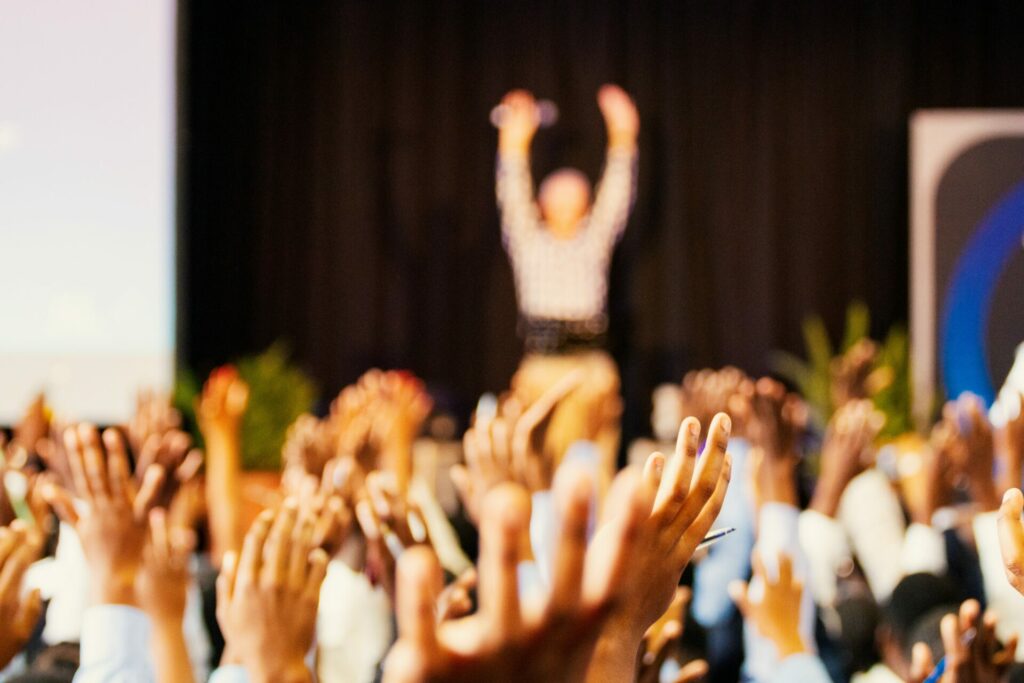
Large group activities for closing a session
So you opened your workshop with large group games that were fun and inclusive, and then included group activities that got the group talking and making important decisions. How then, should you finish the day? What group activities help a team reflect and come away from a workshop with a sense of accomplishment?
The below facilitation techniques will help to effectively close a large group session with any number of people. They are simple, time-bound and allow every group member to share their opinion and find the key takeaways after a workshop or event.
Remember that you should close a session with the same attention and enthusiasm you started with. Group activities such as those below help ensure the energy and success of the session are carried forward and followed up upon.
| Large group game | Length in minutes | Participants | Difficulty |
|---|---|---|---|
| One-breath feedback | 5 – 15 | 2 – 20 | Low |
| Feedback Mingle | 120 – 240 | 2 – 40 | Medium |
| Letter to Myself | 5 – 30 | 2 – 40 | Low |
One-breath feedback
‘Feedback’ has a quite controversial perception. Have you ever met this situation? Someone is asked to present back after a group session and it gets unfocused. It goes on long it’s off the point and people start losing concentration It’s sometimes known as ‘death by feedback’ and can change a group’s perception of the entire session.
This team activity helps to maintain attention and forces everyone to stay concise during a closing round with a natural limit: You are only allowed to share your opinion with just one breath – that is usually no longer than 30 seconds for most people.
In case you have a large group, it works most effectively if you split up the group into circles of 10-15 participants, in order to keep the feedback round under five minutes. Remember that group activities that are timeboxed in this manner can help keep the energy up and ensure you cover everything you need to in time.
Feedback Mingle
Feedback Mingle is a great closing group activity to generate positive energy in any team. At the end of the session, group members are invited to give feedback to every other member of the group via post-it notes. You can use prompt questions to direct the feedback, such as “What I appreciate the most about you…” and “My challenge to you going forward is…”.
After people finished writing a post-it note to everyone else in the group, invite them to mingle and deliver the feedback to each other. The feedback should always happen one-on-one, shared verbally. If you have larger groups, create smaller groups of people who worked together on group activities during the event.
Letter to Myself
You can use this group activity at the end of a workshop or training program to inspire future action. Participants write and send a letter to their future self, in relation to how they will apply the insights and learning they got during the course. For instance, you may ask them to focus on a simple question: “What will I achieve by a certain date?”
When explaining the task, tell the group that you will post the cards/letters in X number of months, and that they should take that into account when writing. You can define the timeframe with the group. Since participants reflect individually in this activity, there is no limitation to scaling this exercise in larger groups.
Designing large group events made easy
Running any event or activity with large numbers of people is a lot to handle. A well-structured agenda is key to facilitating with confidence and staying organized.
With SessionLab, it’s easy to build effective, engaging sessions for groups of any size. Drag, drop and reorder blocks to build your agenda. When you make changes to the plan, your session timing adjusts automatically.
When you’re ready to share your group event with participants and clients, you can invite them to collaborate or create a professional printout to help. you keep on track during the session.
Explore how to use SessionLab to design effective workshops and meetings or watch this five minute video to see the planner in action!
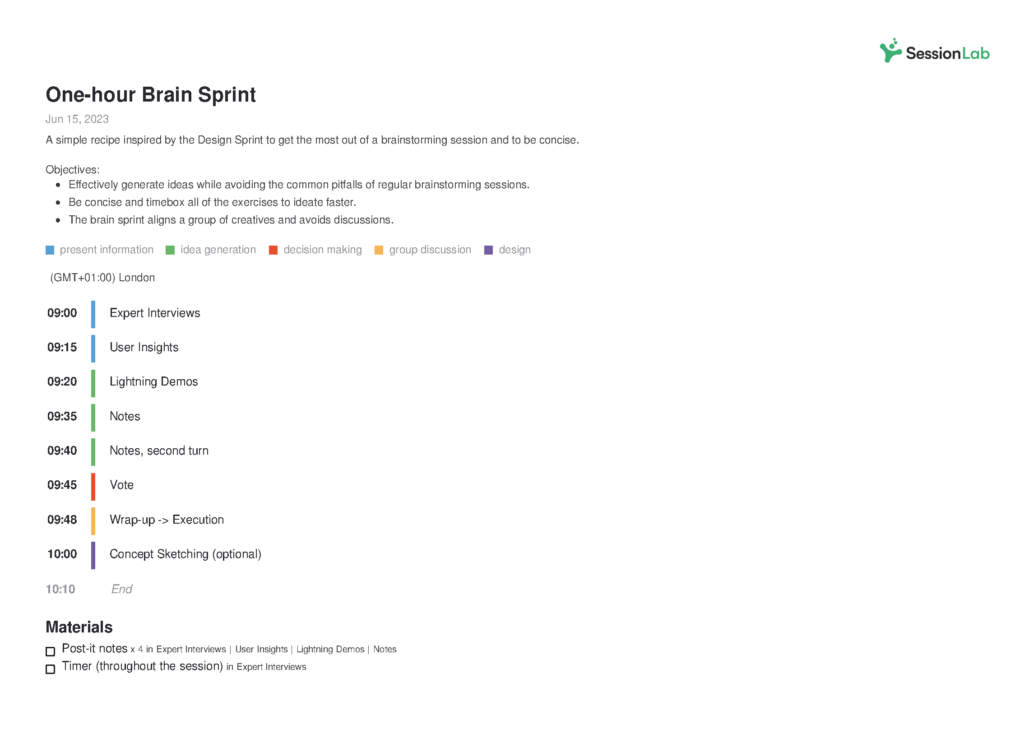
Now over to you…
When you run a group activity that generates energy, laughter and connection in your team, it can have a profound effect on the whole team. I hope you have found some useful tips for running large group games and workshop activities above. Now we’d love to hear from you!
What are your favorite facilitation techniques and games that work well with large groups in workshops, meetings or training sessions? Have you tried any of the methods or group activities above? Let us know about your experiences in the comments.
Want to see even more games and activities? Check out the SessionLab library of facilitation techniques for inspiration and proven methods you can use to improve your meetings, events, and workshops.
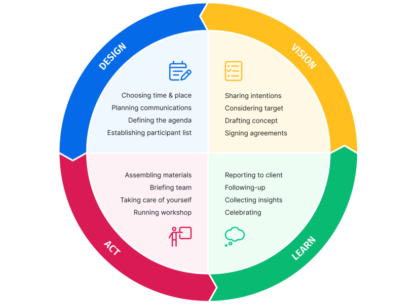
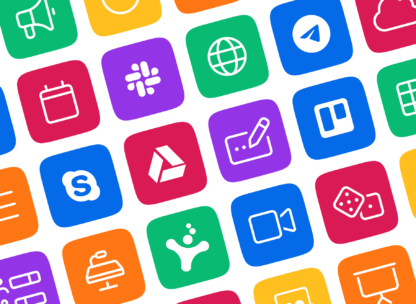
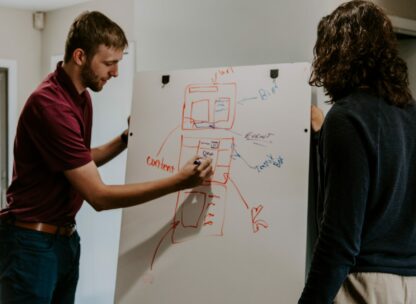
Im trying to look for some workshop games for energizer in some of my trainings. Gotcha! I found this . Thanks for this website.
You’re welcome, Merla!
This blog post is so awesome! Many of these activities are perfect for my team and department–Thanks!!
You’re welcome, that’s wonderful to hear, Syd :-)
True False Run
Another one that sits at the top of the list for obvious reasons – it’s simple, easy to explain, interesting and works well for any sized group. Doesn’t have to involve the running part if your group is less actively inclinced. Be sure to prepare some interesting true/false questions and maybe a good prize for the winner.
Thank you for the suggestion, Alisha! It sounds like and interesting one! Can you tell us a bit more about how to run this exercise?:)
Very interesting thoughts and inputs
You’re welcome, Kannan!
I am looking for a workshop to energize and engage about 200 sales professionals.
Thank you for the question, Veda. You can find dozens of suitable energiser activities in our facilitation library at https://www.sessionlab.com/library/energiser – I hope this helps!
Hi Robert
Quite a vast collection of games I would say. All are quite good .
But I am still look for a game focused on addressing Introductory challenges.
What would you suggest ?
Hi Sanjay. Are you looking for opener activities to kick-off meetings and workshops?
If yes, you might find some practical exercises here for this purpuse here: https://www.sessionlab.com/library/opening
Rob, thanks for these awesome tips.
I will surely try some of them.
Keep sharing such in-depth guides.
Is there any game which I can organize on Teams meeting with 200 users?
HI,
I am looking to get some activities for a self discipline workshop for adults, can you recommend some ?